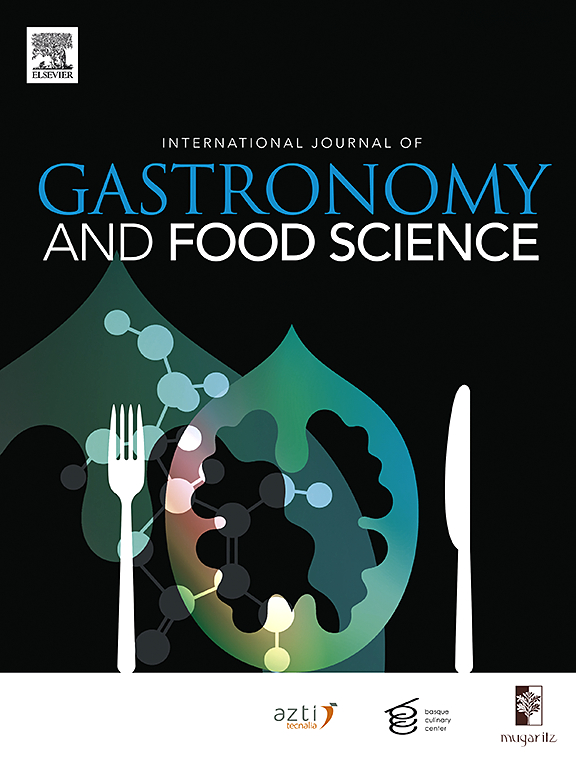Reflections of Turkey-Greece population exchange on Manisa Alaşehir culinary culture
IF 3.6
2区 农林科学
Q2 FOOD SCIENCE & TECHNOLOGY
International Journal of Gastronomy and Food Science
Pub Date : 2025-09-24
DOI:10.1016/j.ijgfs.2025.101309
引用次数: 0
Abstract
Anatolia, with its geopolitical position, climatic characteristics, and fertile lands, is an ancient region that has hosted numerous civilizations and experienced significant migration phenomena. One of the notable migrations in this region in recent centuries is the population exchange. The population exchange occurred between Turkey and Greece under an agreement supplementary to the Lausanne Peace Treaty. As a result of this agreement, citizens of both countries were subjected to compulsory migration based on their religious beliefs and are referred to as exchangees. Among the settlements in Turkey where exchangees are densely populated is the Alaşehir district of Manisa province. Within this context, the purpose of this study is to examine the elements of exchangee culinary culture within the Alaşehir cuisine. The research adopts a qualitative approach, with data collected through semi-structured interview forms. Employing purposive sampling, the study includes 13 participants who were forcibly migrated to the district as a result of the population exchange. Content analysis of the data obtained from participants was conducted under five main themes: “Population Exchange, Food and Beverage, Culinary Practices, Events, and Traditionality.” Beyond the deep historical roots of exchangee cuisine, significant findings were obtained regarding dishes, cooking techniques, preservation methods, tools and equipment, gastronomic products, meals, and ceremonies associated with the exchangee culinary culture. In this regard, the study is expected to contribute to the preservation of the traditional structure of Alaşehir's exchangee culinary culture while fostering the development of a sustainability perspective.
土耳其-希腊人口交流对马尼萨地区饮食文化的思考
安纳托利亚拥有得天独厚的地缘政治位置、气候特点和肥沃的土地,是一个承载了众多文明并经历了重大移民现象的古老地区。近几个世纪来,这个地区引人注目的迁徙之一是人口交换。土耳其和希腊之间的人口交换是根据《洛桑和平条约》的补充协定进行的。由于这项协定,两国公民都因其宗教信仰而被迫移徙,并被称为交换者。在土耳其,交易所人口密集的定居点之一是马尼萨省的alaemail区。在此背景下,本研究的目的是研究阿拉海地区烹饪文化中的交流元素。本研究采用定性方法,通过半结构化访谈形式收集数据。本研究采用有目的抽样,包括13名因人口交换而被迫迁移到该地区的参与者。从参与者那里获得的数据内容分析是在五个主题下进行的:“人口交流、食品和饮料、烹饪实践、活动和传统。”除了交流饮食的深厚历史根源之外,还获得了与交流饮食文化相关的菜肴、烹饪技术、保存方法、工具和设备、美食产品、膳食和仪式等方面的重大发现。在这方面,这项研究预计将有助于保护阿拉木图交换饮食文化的传统结构,同时促进可持续发展的观点。
本文章由计算机程序翻译,如有差异,请以英文原文为准。
求助全文
约1分钟内获得全文
求助全文
来源期刊

International Journal of Gastronomy and Food Science
Social Sciences-Cultural Studies
CiteScore
5.30
自引率
10.50%
发文量
170
审稿时长
45 days
期刊介绍:
International Journal of Gastronomy and Food Science is a peer-reviewed journal that explicitly focuses on the interface of food science and gastronomy. Articles focusing only on food science will not be considered. This journal equally encourages both scientists and chefs to publish original scientific papers, review articles and original culinary works. We seek articles with clear evidence of this interaction. From a scientific perspective, this publication aims to become the home for research from the whole community of food science and gastronomy.
IJGFS explores all aspects related to the growing field of the interaction of gastronomy and food science, in areas such as food chemistry, food technology and culinary techniques, food microbiology, genetics, sensory science, neuroscience, psychology, culinary concepts, culinary trends, and gastronomic experience (all the elements that contribute to the appreciation and enjoyment of the meal. Also relevant is research on science-based educational programs in gastronomy, anthropology, gastronomic history and food sociology. All these areas of knowledge are crucial to gastronomy, as they contribute to a better understanding of this broad term and its practical implications for science and society.
 求助内容:
求助内容: 应助结果提醒方式:
应助结果提醒方式:


